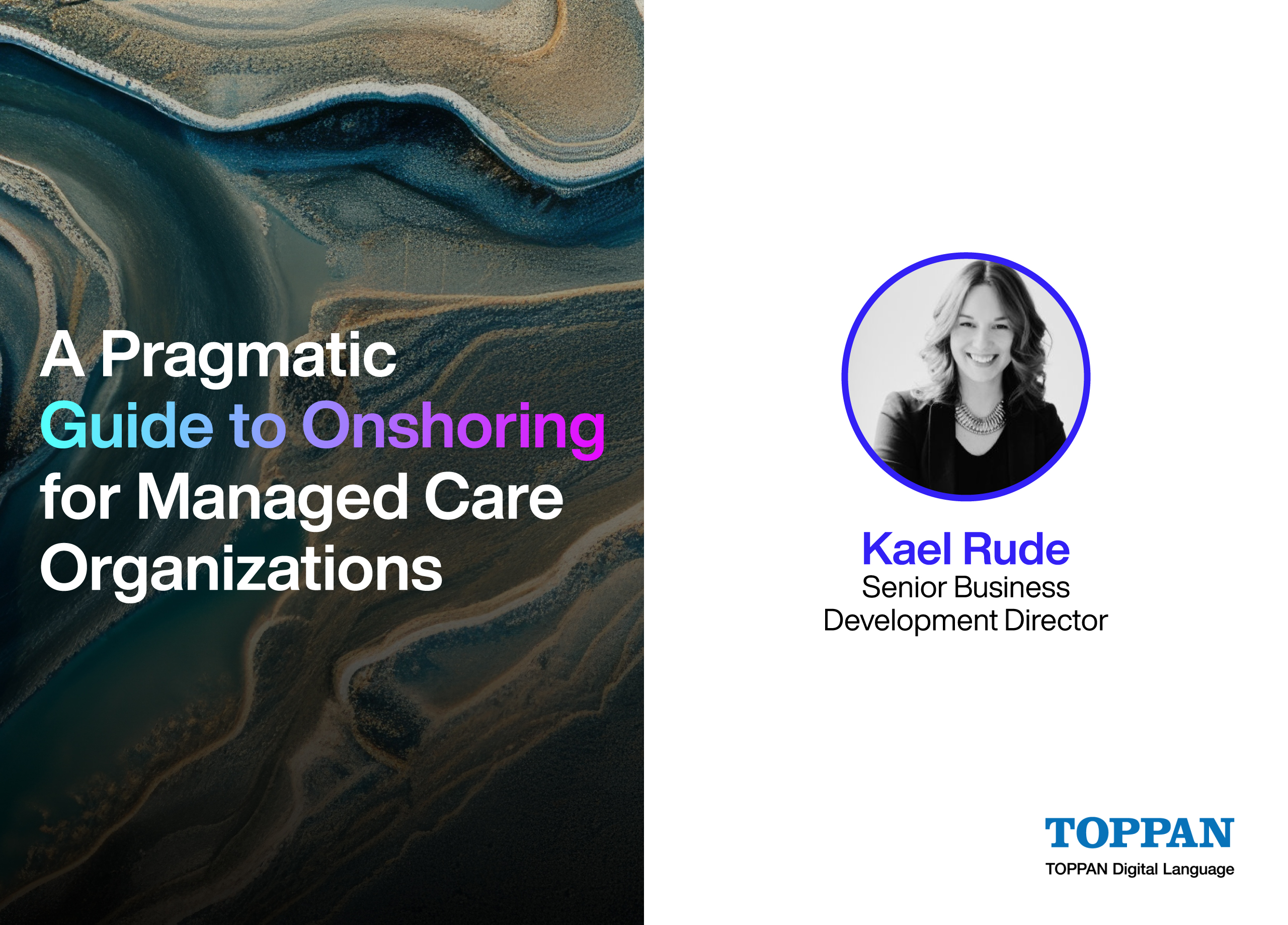If you work within a regulated industry in the United States, you’ve likely noticed the shift toward onshoring within your language and content operations. Healthcare is no exception.
What used to be a variable requirement is becoming the rule of thumb for everything involving Protected Health Information (PHI) or Personally Identifiable Information (PII).
The change is both policy and risk management-driven, aiming to meet an informational age that is increasingly digital, portable and linked to member and patient outcomes.
HITRUST and SOC-2, the industry’s leading information security frameworks, don’t explicitly mandate onshore processing of sensitive content. But many managed care and healthcare providers require it as an additional layer of protection. Many states also require onshoring for their Medicaid, Medicare and community plan materials.
We answer questions about the benefits and process of onshoring in this pragmatic guide, outlining the steps U.S. healthcare organizations can take to align onshore operations with long-term security and business goals.
Define Onshoring
Onshoring is conceptually straightforward, but there are nuances in its interpretation and implementation that impact its execution and monitoring. Therefore, defining what it means for your organization can ensure compliance with regulatory and internal requirements and avoid months of rework down the line.
Onshoring can include various levels of controls:
- Data residency: PHI and PII content is kept on U.S. servers
- End-to-end processing: The hosting, operational production, and delivery of sensitive content is carried out within the U.S.
- U.S. teams: All project staff and support roles are U.S.-based
- Access restricted areas: Sensitive content can’t leave a specific secure location, and user permissions are role-based and traceable
- Contiguous vs. Non-contiguous: Depending on an organization’s requirements, onshoring either includes or excludes continental U.S. states and territories
The controls selected should be documented in statements of work with external partners to ensure a shared understanding of and compliance with those controls. Additionally, workflows should be mapped out to its corresponding control. This accelerates legal and security reviews and prevents scope creep and unnecessary costs.
What good onshoring looks like
Best-in-class onshore programs unify technology, process and supply under one operating model. U.S.-based healthcare organizations should use HIPAA-compliant, ISO 27001-certified and, where indicated, HITRUST or SOC-2 certified platforms hosted in the United States. Encryption should be used when data is sent and stored, with granular access controls and audit-ready logging.
You should also limit PHI and PII workflows where indicated to US-based teams, and centralize linguist, project manager and QA activities within a secure environment so data cannot leak into email or local machines.
Because onshoring limits the linguistic capacity available for translation initiatives, particularly for uncommon language pairs, adding buffer to project deadlines and budgets is an important part of the planning process. Secure AI-assisted translation workflows offer a solution to capacity and budget pressures. Maintaining human-in-the-loop controls within the process eases capacity and cost pressures while maintaining certifiable-level quality and compliance.
The practical economics of onshoring
Onshoring often requires upfront financial investment; the required physical and technical security measures, as well as a narrower supplier pool, can add overhead. But with proper planning and scope alignment with your external partners, these additional costs are predictable and controllable, helping you to budget and manage SLAs with confidence.
By contrast, the legal exposure, remediation, lost productivity and brand damage resulting from a data breach are volatile and expensive. A steady premium is often cheaper than a single incident that spirals.
You should use onshoring where it matters most: route work by clear policy, not one-off exceptions. That way you balance cost with risk and keep compliance intact.
How we implemented onshoring for a customer
A top U.S. managed care provider was generating thousands of member letters a week in support of multiple state Medicare/Medicaid/Dual plans. Some states required onshore processing due to the high degree of PHI, but others approved offshore processing.
Rather than default to processing all letters onshore, and pass the cost of doing so on to our client, we helped our client define onshoring rules and created routing logic that bifurcated letters into one of two workstreams within our secure platform.
Each letter flowed to the correct path automatically based on state-specific requirements, and we translated the documents with onshore linguists as indicated. PHI content for onshore states remained on U.S. servers with U.S.-based project teams and strict access controls. Content for offshore-approved states followed a separate path that enabled external contributions while still complying with HITRUST and ISO 27001 security standards.
Compliance remained consistent and SLAs were met during volume peaks because capacity was planned accordingly. Costs also aligned with budgets because only mandated content ran fully onshore.
As a result, this critical content arrived on time and in the right language to ensure a positive member experience. Our client’s procurement and information security teams were satisfied because controls were documented, auditable and predictable.
Your first 30 days
If you’re starting or upgrading an onshoring path, start small.
- Map data flows. List all programs and workflows that handle PHI or PII.
- Choose the controls. For each workflow, choose data residency only or end-to-end United States processing. Add staffing rules if needed.
- Lock your content workflows. Encryption, U.S. hosting, logging and role-based access. PHI and PII should existing nowhere except within the environment.
- Develop a U.S. focused rotation for your core languages. If you’re using AI translation, ensure secure HIPAA-complaint processes with human reviewers.
- Use routing rules for the right work type on the right lane based on contract or state policy.
- Measure and iterate. Monitor turnover, accuracy and exceptions. Fine-tune the mix quarterly.
Onshoring at its core is about clarity, consistency and control. Ensure you define it right, ensure the right workflows and let the rules do the heavy lifting. Your members and patients get safer, more understandable communication. And you get fewer headaches with operations and clear evidence of compliance for auditors.

